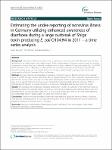Estimating the under-reporting of norovirus illness in Germany utilizing enhanced awareness of diarrhoea during a large outbreak of Shiga toxin-producing E. coli O104:H4 in 2011 – a time series analysis
Bernard, Helen
Werber, Dirk
Höhle, Michael
Background: Laboratory-confirmed norovirus illness is reportable in Germany since 2001. Reported case numbers are known to be undercounts, and a valid estimate of the actual incidence in Germany does not exist. An increase of reported norovirus illness was observed simultaneously to a large outbreak of Shiga toxin-producing E. coli O104:H4 in Germany in 2011 – likely due to enhanced (but not complete) awareness of diarrhoea at that time. We aimed at estimating age- and sex-specific factors of that excess, which should be interpretable as (minimal) under-reporting factors of norovirus illness in Germany. Methods: We used national reporting data on laboratory-confirmed norovirus illness in Germany from calendar week 31 in 2003 through calendar week 30 in 2012. A negative binomial time series regression model was used to describe the weekly counts in 8∙2 age-sex strata while adjusting for secular trend and seasonality. Overall as well as age- and sex-specific factors for the excess were estimated by including additional terms (either an O104:H4 outbreak period indicator or a triple interaction term between outbreak period, age and sex) in the model. Results: We estimated the overall under-reporting factor to be 1.76 (95% CI 1.28-2.41) for the first three weeks of the outbreak before the outbreak vehicle was publicly communicated. Highest under-reporting factors were here estimated for 20–29 year-old males (2.88, 95% CI 2.01-4.11) and females (2.67, 95% CI 1.87-3.79). Under-reporting was substantially lower in persons aged
Dateien zu dieser Publikation
Keine Lizenzangabe

